| Srl | Item |
| 1 |
ID:
131791
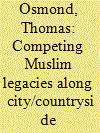

|
|
|
|
|
| Publication |
2014.
|
| Summary/Abstract |
Between the Middle East and Eastern Africa, the city of Harar is often considered as the main historical centre of Islam in Ethiopia and the Horn of Africa. Until recently, the cultural hegemony of the Muslim elites inhabiting Harar was commonly opposed to the almost pagan behaviours of the Oromo - or 'Galla' - farmers and cattle herders living in the wide rural vicinity of the town. The 1995 Constitution provided the different 'ethnolinguistic nationalities' of the new Ethiopian federation with the same institutional recognition. However, the institutionalisation of the two Harari and Oromo 'nationalities' seems to foster the historical duality between the city-dwellers and their close neighbours. This article proposes another political history of Harar and its ambivalent Oromo partners through the local dynamics of the Muslim city/countryside models. It reveals the both competing and complementary orders that have probably bound together the populations of Harar and its rural hinterland for more than five hundred years.
|
|
|
|
|
|
|
|
|
|
|
|
|
|
|
|
| 2 |
ID:
099155
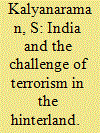

|
|
|
|
|
| Publication |
2010.
|
| Summary/Abstract |
Terrorism in the Indian hinterland is the result of a complex set of inter-related factors. The development of a jihad culture in Pakistan during the course of the Afghan conflict in the 1980s led to the subsequent Pakistani decision to employ jihad against India as a strategy. The mobilisation of the Hindu Right in India and ensuing communal violence led to the radicalisation of Muslim youth and the resort to terrorism by both Indian Islamists and Muslim criminal networks with help from Pakistan. Terrorist attacks by Pakistani jihadists and Indian Islamists, in turn, radicalised elements within the Hindu Right and set the stage for their turn towards terrorism in the last few years.
|
|
|
|
|
|
|
|
|
|
|
|
|
|
|
|
| 3 |
ID:
130641
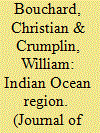

|
|
|
|
|
| Publication |
2013.
|
| Summary/Abstract |
The African littoral of the Indian Ocean is a significant part of the Indian Ocean region. In the context of the IOR-ARC, focus is given to the African littoral of the Indian Ocean Rim, which consists of 10 states plus three French island territories. However, an African Indian Ocean extended area of 24 states plus the French islands can be identified as part of the broader Indian Ocean region, to which we refer as the African Indian Ocean littoral and hinterland. This highlights the fact that the African land-locked states represent a pertinent and significant dimension to the relation between the African littoral and the rest of the Indian Ocean region. Overall, this African Indian Ocean littoral and hinterland is a region of low socio-economic development facing many challenges. Nonetheless, it is a region on the move, and some substantial improvements can be expected during the entire twenty-first century. The potential, and perhaps even expected outcome of a much larger and healthier population, a better performing and more open economy, and an increase in and more efficient management of maritime activities will set the scene for the rising significance of the African littoral to both the Indian Ocean region and the Indian Ocean Rim, thus also increasing its geopolitical and geostrategic significance.
|
|
|
|
|
|
|
|
|
|
|
|
|
|
|
|
| 4 |
ID:
134172


|
|
|
|
|
| Publication |
2014.
|
| Summary/Abstract |
A common criticism levelled at successive governments of the Republic of Ireland during the Northern Ireland 'Troubles' was their alleged inactivity in the face of a ferocious Provisional IRA campaign. Such criticisms were based in large part on the perception of the southern state as a supply base for militant republicanism. The Republic was undoubtedly a formidable logistics hinterland for such militants. However, criticisms of the reactions of authorities in the south are unfair. This article considers the explosives capabilities of the IRA during the first six years of their campaign. It does so with reference to their attempts to obtain commercial explosives as well as measures employed by them to obtain homemade explosives. The article also considers countermeasures employed by the southern government and reveals the extent to which they sought to shut down IRA capabilities in the south. It is argued that, ultimately, the IRA's campaign in this regard could only be contained and never unilaterally halted.
|
|
|
|
|
|
|
|
|
|
|
|
|
|
|
|
| 5 |
ID:
148494
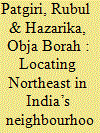

|
|
|
|
|
| Summary/Abstract |
India’s neighbourhood policy seems to be devoid of any strategy to integrate national interests with the concerns of border regions like Northeast India. India’s security-centric approach prevented a cooperative relationship from emerging with its neighbours, while a deeper and intense engagement with them would have benefitted India and helped solve many of the problems that Northeast India is facing today. However, the recent move by India under the Act East Policy to cultivate a much closer relationship with its eastern neighbours is full of possibilities to make India’s neighbourhood policy more accommodative and sensitive towards the needs of Northeast India. In the light of this, the proposed article intends to examine the nature of India’s neighbourhood policy, to assess its implications for the Northeast and finally, to examine whether the recent transnational engagements can initiate development of the Northeast by relieving it from its peripheral and landlocked status.
|
|
|
|
|
|
|
|
|
|
|
|
|
|
|
|
| 6 |
ID:
103781
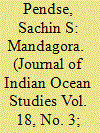

|
|
|
| 7 |
ID:
128120
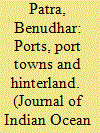

|
|
|
|
|
| Publication |
2013.
|
| Summary/Abstract |
Palur was another important port on the coast of ancient Odisha. It occupied an enviable position on the trade-route between India and South East Asia and acted as the only port of departure to the far reference to this port appears in the work of the Greek sailor Ptolemy during the 2nd century EC who has named it as Paloura.
|
|
|
|
|
|
|
|
|
|
|
|
|
|
|
|
| 8 |
ID:
178307
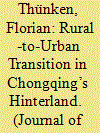

|
|
|
|
|
| Summary/Abstract |
Since 2014 the Chinese state has been pushing for “new-style urbanisation.” Its main goals are accelerated urban–rural integration, development of small-to-medium cities and towns, and a “people-centered” urbanisation, all while limiting movement towards big cities. Similar reforms have been experimented with in Chongqing since 2007. This article argues that we need to take both top-down and bottom-up processes into view if we are to understand completely the intricate transformation currently underway in China’s urbanising society. Thus, policies and programmes at the national and provincial level are examined and then contrasted with findings from field research, that has been conducted in Chongqing’s urbanising hinterland. Findings show patterns of rural-to-urban transitioning which apparently match the central and municipal governments’ plans, but further evidence points to the rejection or modification of state-led urbanisation efforts and towards an urbanisation on the people’s own terms.
|
|
|
|
|
|
|
|
|
|
|
|
|
|
|
|